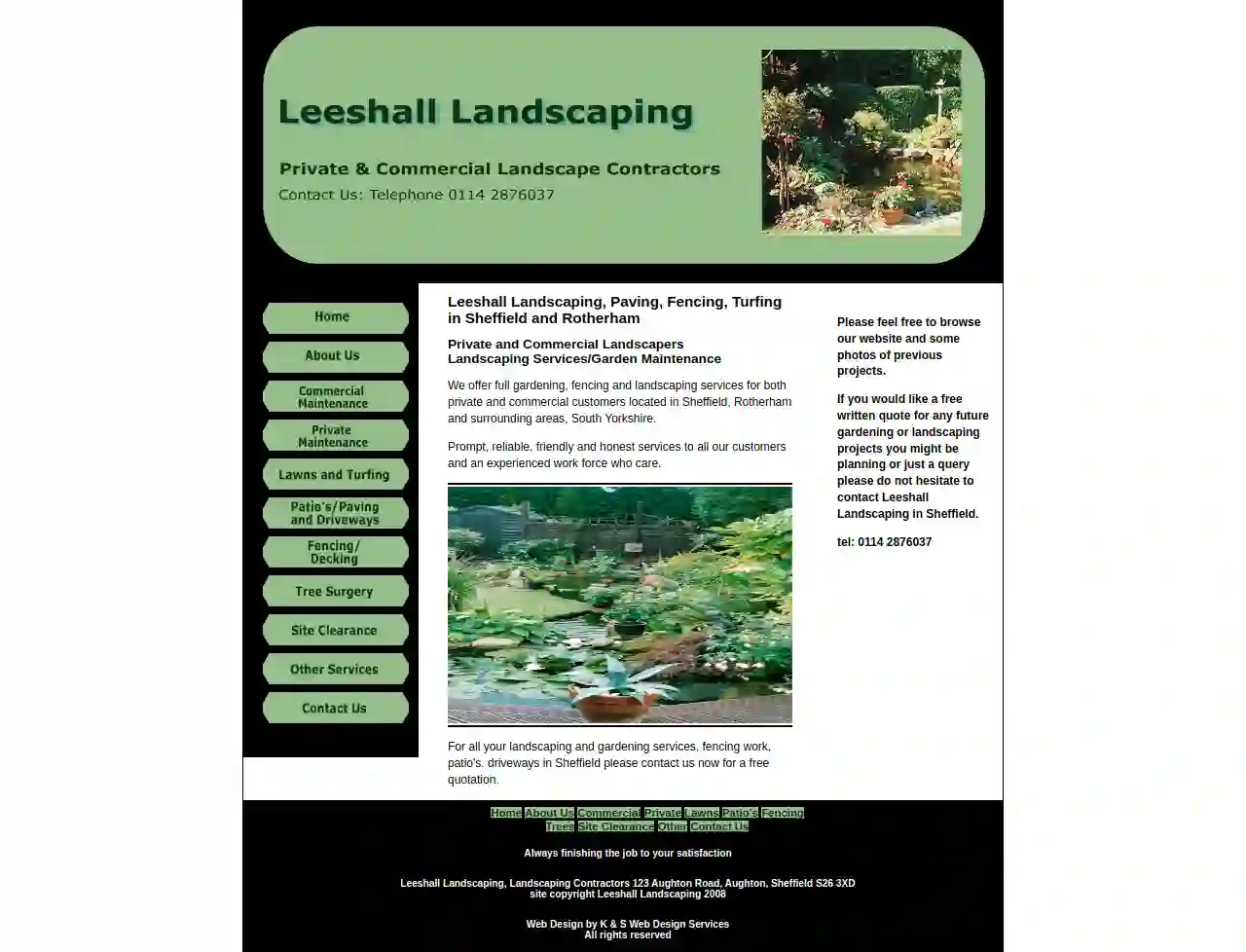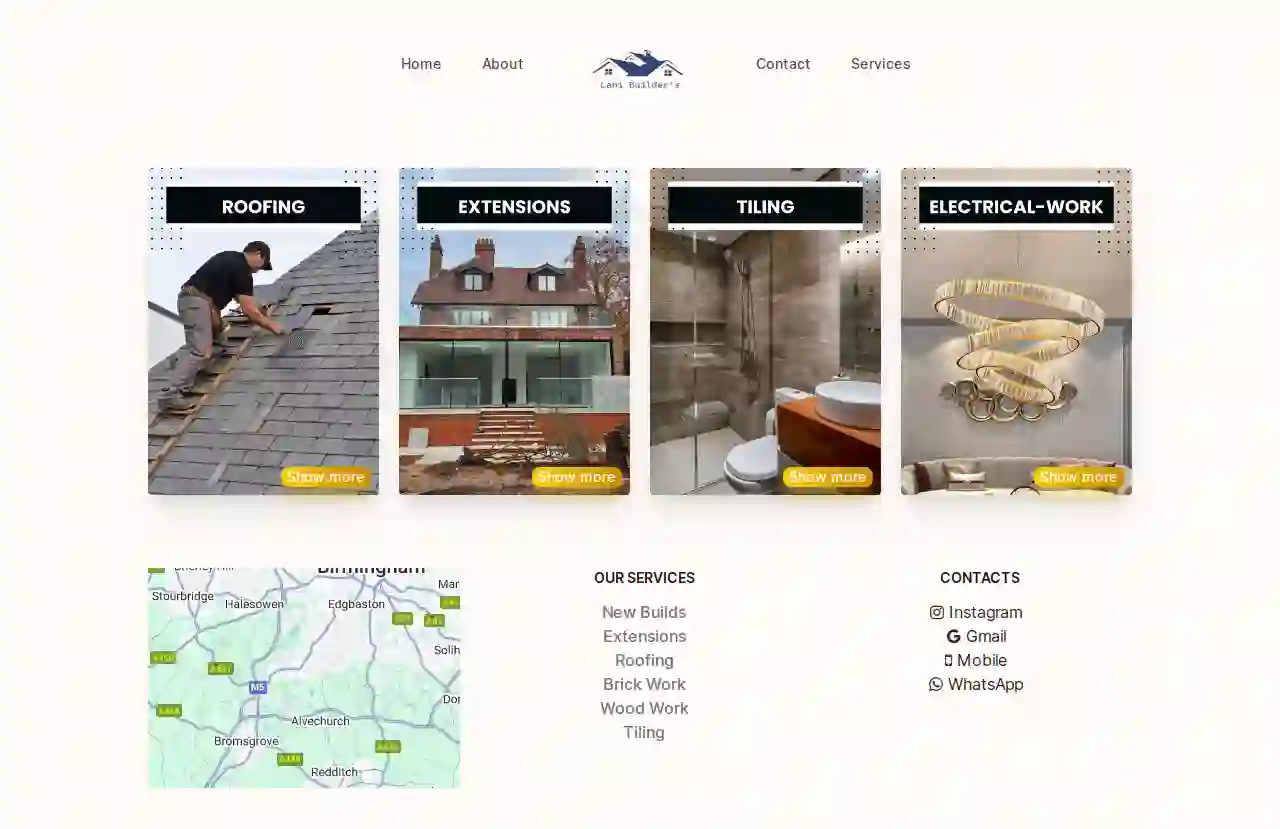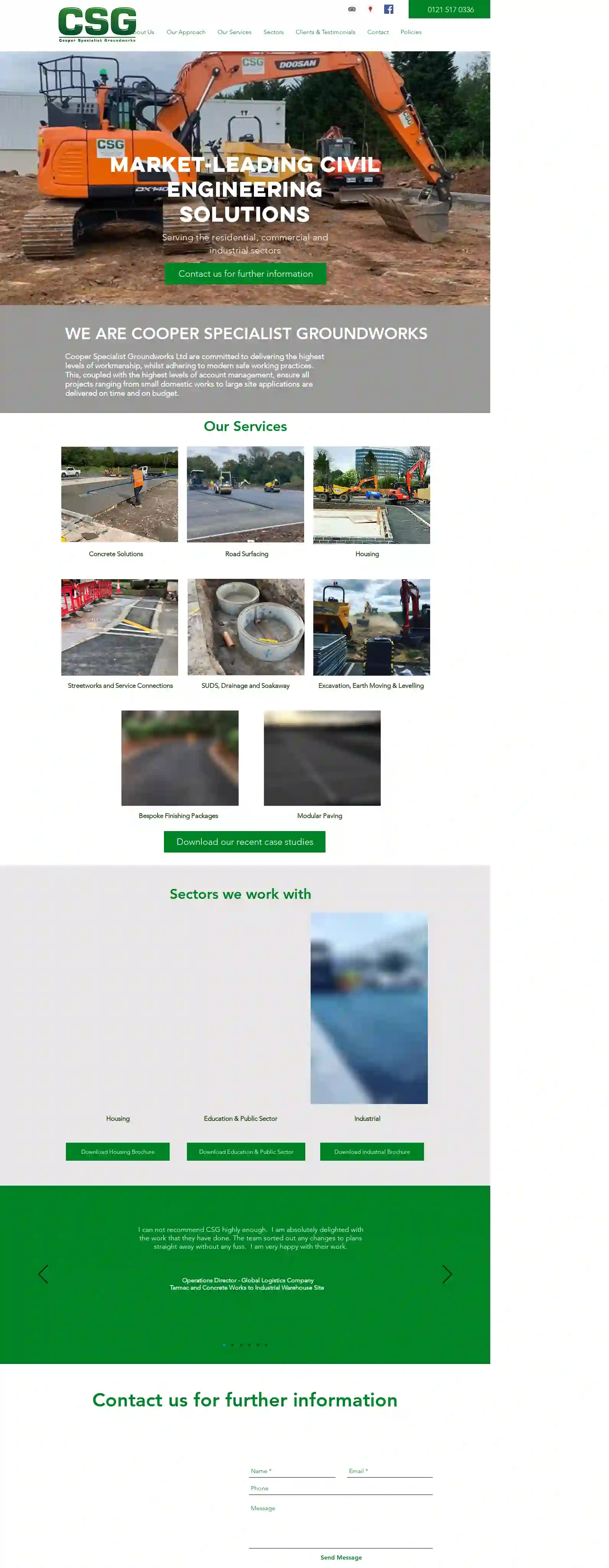Excavation Contractors Bickenhill
Top 10 Excavation Services in Bickenhill
Get up to 3 Trenching Services quotes for your project today! Compare profiles, reviews, accreditations, portfolio, etc... and choose the best service.

Solihull Builder
56 reviewsSolihull, GBWelcome to Solihull Builder We have over 20 years experience offering builder services in Solihull from start to finish full house renovation and everything inbetween. We understand the importance of completing successful building projects that are not only to our high standards and finish but also always ensuring projects are completed on time and within budget. Building is complex and highly important for your property and we are extremely passionate about all of our work and consistently aim to exceed the satisfaction of all of our clients. We are fully qualified and accredited giving reassurance that you are now in safe hands and this is why Solihull Builder are known for exceptional standards and expert property building services whilst remaining approachable and supportive to all of our clients needs.
- Services
- Why Us?
- Testimonials
- Gallery
Get Quote
SSG Contracts
34 reviewsDrayton Court, Drayton Road, Solihull, B90 4NG, GBAbout SSG SSG was founded on the principles of trust, honesty, reliability, and commitment. Established over 20 years, SSG was founded on the principles of trust, honesty, reliability, and commitment which sit at the very heart of the company’s DNA and its approach to serving its customers through its committed teams. Our mission is to provide a broad range of exceptional services and the highest quality solutions to our customers – whatever the requirement. We are passionate about seeing the customers we support not only succeed, but to prosper and grow along every step of the journey. Over 20 years knowledge and experience. We undertake all aspects of commercial works across the retail, education, logistics, industrial and residential sectors. We support an ever increasing range of customers including many large multi-nationals and well known, market leading organisations including for the likes of Amazon, Aston Martin, British Gas, CBRE, Fedex, KWB, Jaguar Land Rover, National Grid, Potter Group, Prologis to name but a few. People are at the heart of our business. Our teams have a broad and deep wealth of expertise in everything from design, civil engineering and project management to highly specific, sought-after skills such as building information management and engineering for net zero carbon. They are both disruptors and collaborators. And they get the job done.
- Services
- Why Us?
- Our Team
- Gallery
Get Quote
Lees Hall Landscaping
4.58 reviews123 Aughton Road, Aughton, Sheffield, S26 3XD, GBWelcome to Leeshall Landscaping Leeshall Landscaping is a Sheffield-based company offering a wide range of landscaping and gardening services to both private and commercial customers in Sheffield, Rotherham, and surrounding areas. We are committed to providing prompt, reliable, friendly, and honest services to all our customers. Our experienced workforce takes pride in delivering high-quality work that meets your specific needs and exceeds your expectations. We specialize in: Fencing Decking Patios Paving Driveways Commercial Grounds Maintenance Site Clearance Whether you're planning a complete garden makeover, need a new fence installed, or require regular lawn maintenance, Leeshall Landscaping is here to help. We offer free written quotes for all our services, so don't hesitate to contact us today to discuss your project. We are passionate about creating beautiful and functional outdoor spaces that you can enjoy for years to come. Browse our website to see examples of our previous projects and get inspired for your own landscaping dreams.
- Services
- Why Us?
- Gallery
Get Quote
Lani Builders
525 reviews23 Cofton Grove, Northfield, Birmingham, B31 4NP, GBAbout Us We are a small passionate team dedicated to providing high-quality building services to our clients. We take pride in our work and strive to deliver exceptional results that exceed expectations. Our team of experienced builders is committed to delivering projects on time and within budget. We understand the importance of clear communication and work closely with our clients throughout the entire process. Whether you're looking for a new build, an extension, or roofing work, we have the expertise and experience to handle your project with care and precision. Contact us today to discuss your project and get a free quote.
- Services
- Why Us?
- Gallery
Get Quote
Solihull Groundworks
51 reviewsVirginia House, 56 Warwick Road, Virginia House 56 Warwick Road Solihull, Solihull, B92 7HX, GBMarket-leading Civil engineering solutions Serving the residential, commercial and industrial sectors Contact us for further information WE ARE COOPER SPECIALIST GROUNDWORKS Cooper Specialist Groundworks Ltd are committed to delivering the highest levels of workmanship, whilst adhering to modern safe working practices. This, coupled with the highest levels of account management, ensure all projects ranging from small domestic works to large site applications are delivered on time and on budget.
- Services
- Why Us?
- Testimonials
- Gallery
Get Quote
Aylesbury Developments Ltd
11 reviews39 Aylesbury Rd, Hockley Heath, Solihull, B94 6PD, GBWelcome to Aylesbury Developments Reliable, Recommended Builders in Solihull Our passion for craftsmanship has made us the leading choice for extensions, renovations and groundworks in Solihull and the surrounding areas. request a quote Why choose us as your Builders in Solihull? End-to-End Solutions We oversee every aspect of your construction project, from the initial planning phase to the final completion. You can trust us to manage every detail. Local Expertise Working with a trusted network of qualified local subcontractors, we understand the unique needs of the Solihull area when it comes to planning, regulations, and architecture. Family-Run Craftsmanship With a talent for craftsmanship passed down through the generations, our skilled team is committed to delivering the highest standards of quality, ensuring your project stands the test of time. Transparent Communication We believe in open and honest communication throughout the project. You’ll always be informed and involved in every decision, with a full quote in writing. About our Solihull builders With over 20 years of experience in the industry, Aylesbury Developments has earned a stellar reputation for delivering exceptional building solutions. A tight-knit team of trusted and reliable builders in Solihull, we are dedicated to delivering exceptional construction services, including bespoke home extensions, kitchen and bathroom renovations, and watertight groundwork and drainage. We manage your project from planning to completion for one seamless point of contact throughout, saving you the stress of liaising with multiple subcontractors, and juggling multiple budgets and timelines. more about us More about our building work Customised Transformations Every space we create is built with your lifestyle in mind. We work directly with you to develop bespoke extensions and renovations, crafted around your unique needs. Energy Efficient For a space you can make full use of all year round, we incorporate energy-saving features and materials to reduce your energy bills and environmental impact.
- Services
- Why Us?
- Gallery
Get Quote
M J Coles Construction Services Ltd
4.58 reviewsThe Gatehouse, Unit B2, Earlswood Trading Estate, Poolhead Lane, Solihull, B94 5EW, GBBuilding Excellence for Your Business Welcome to MJC, a leading commercial construction company with a steadfast commitment to delivering excellence in every project we undertake. From shopfitting and groundworks to commercial painting and decorating, our comprehensive range of services caters to diverse commercial clients across the UK. The MJC Mission At MJC, our mission is to make commercial refurbishment as smooth and painless as possible by bringing a high level of expertise, professionalism, and past experience to every project. We strive to build long-lasting relationships with our clients, based on trust, integrity, and open communication. We take pride in transforming your plans into reality while ensuring the highest standards of craftsmanship and exceptional project outcomes. 40 Years of Commercial Construction Experience Our Story At its heart, MJC is a family-run brand with a national corporation standard of expertise. Since its establishment, the business has grown exponentially building on successes year after year and benefitting from long-lasting relationships built with legacy UK brands. With a head office conveniently based in Central England and a fleet of vehicles and company-owned equipment, we can quickly mobilise to meet your project needs. Every project is seamlessly managed by our in-house administration staff, while carefully vetted subcontractors are selected according to the needs of each project. Our Core Values Craftsmanship: We are relentless in our pursuit of quality craftsmanship. From the smallest boutique stores to the largest corporate chains, we aim for perfection, using our expertise, experience, and passion to deliver exceptional results that stand the test of time. Integrity: Honesty, transparency, and ethical conduct are at the heart of our business. We value the trust placed in us by our clients, employees, and partners, and we strive to maintain the highest standards of integrity in all our interactions. Collaboration: We believe that collaboration is the key to success. We foster a culture of open communication and teamwork, working closely with our clients, suppliers, and subcontractors to ensure that every project is delivered on time and within budget.
- Services
- Why Us?
- Gallery
Get Quote
Brookbanks
51 reviews6150 Knights Court, Solihull Parkway, Birmingham Business Park, Birmingham, B37 7WY, GBLooking for more information about our services? Have you got project plans you’d like to discuss? We’re here to help - get in touch with us. Brookbanks is a leading provider of engineering and development consultancy services. We have a proven track record of delivering successful projects across a wide range of sectors. Our team of experienced professionals is committed to providing our clients with the highest quality of service and support. We are passionate about helping our clients achieve their goals and we are always looking for new and innovative ways to deliver value. We are a team of passionate and experienced professionals who are dedicated to delivering exceptional results for our clients. We understand that every project is unique and we take a tailored approach to ensure that we meet the specific needs of our clients. We are committed to providing our clients with the highest quality of service and support, and we are always looking for new and innovative ways to deliver value. We are committed to providing our clients with the highest quality of service and support. We are always looking for new and innovative ways to deliver value. We are a team of passionate and experienced professionals who are dedicated to delivering exceptional results for our clients. We understand that every project is unique and we take a tailored approach to ensure that we meet the specific needs of our clients.
- Services
- Why Us?
- Gallery
Get Quote
Heritage Drives & Landscapes
547 reviewsSunnyside, Kenilworth Road, Hampton In Arden, Solihull, West Midlands, B92 0LW, GBProfessional Landscaping and Driveways Company Solihull Heritage Drives & Landscapes Ltd specialises in all aspects of garden landscaping and fitting driveways in Solihull and the surrounding areas. Looking for some hardscaping or a new resin driveway? Our team of professional driveway pavers and landscapers can help! We are a family-run business that prides itself on our craftsmanship and customer service. Our professional landscaping and driveways company Solihull boasts over 25 years of hands-on experience and a team of highly experienced professionals. Heritage Drives & Landscapes work throughout Solihull, Warwickshire, and the West Midlands, including: Coventry, Royal Leamington Spa, Stratford-upon-Avon, Balsall Common, Henley-in-Arden, and the surrounding areas. Learn more about our professional landscaping and driveway services. Don’t hesitate to contact us. Call us or email us at [email protected].
- Services
- Why Us?
- Gallery
Get Quote
Umberslade: Strip Out & Groundworks
4.853 reviewsLadywood Farm, Elvers Green Lane, Ladywood Farm Elvers Green Lane Knowle Solihull, Solihull, B93 0AA, GBminiMUM fuss. MAXIMUM service. No matter which of our services you use, our mission is to deliver the highest standard of service, and quality of work, at a competitive price. We call our mission SnagZero™: it's our commitment to minimise risk, delay and complication, and maximise expertise, efficiency & safety, to reliably deliver a zero-snag project. The UK's specialist for over 25 years Established in 1996, we’re the UK's largest & most experienced specialist in strip out. Conveniently located in the Midlands, our expert teams provide soft strip out, M&E strip out and internal demolition services across the UK for refurbishment specialists & constructors, working in a wide range of industry sectors. Much of our work stems from returning customers and referrals - we’ve worked with some of our clients for three decades. Our SnagZero™ commitment ensures every project is completed to the highest standard; on-time, on-budget and most importantly, safely. Umberslade has specialised in soft strip out & internal demolition for over 25 years. We are the leader in strip out with the UK's largest full-time team of experienced CCDO-qualified operatives. Our Midlands Groundworks division works across both the West Midlands and East Midlands for leading construction companies, delivering snag-free projects from £10k-£1.5m in value.
- Services
- Why Us?
- Gallery
Get Quote
Over 13,059+ Excavation Companies on our platform
Our excavation experts operate in Bickenhill & surroundings!
ExcavationHQ has curated and vetted Top Excavation Contractors near Bickenhill. Find the most trustworthy business today.
Frequently Asked Questions About Excavation Contractors
- Spring and Fall: Often considered favorable due to moderate temperatures and drier soil conditions.
- Summer: Can be suitable, but hot weather can make working conditions challenging and might require additional measures (shade, hydration) for workers.
- Winter: Excavation in winter can be more difficult due to frozen ground, snow, and potential delays caused by inclement weather. It might also require specialized equipment or techniques.
- Project Type and Size: Ensure the contractor has experience handling projects similar to yours in scale and complexity.
- Reputation and Reviews: Check online reviews and testimonials, and request references from previous clients.
- Licensing and Insurance: Verify that the contractor is properly licensed and insured to protect you from liability.
- Equipment and Resources: Confirm that they have the necessary equipment and resources for your project's needs.
- Communication and Transparency: Choose a contractor who communicates clearly, provides detailed estimates, and keeps you informed throughout the project.
- Safety Record: Inquire about their safety protocols and track record to ensure a safe work environment.
- Price: While price is important, it shouldn't be the only deciding factor. Balance affordability with experience, reputation, and quality of service.
- Topsoil Removal: Stripping the fertile topsoil layer from a site, often preserving it for landscaping.
- Trench Excavation: Digging long, narrow trenches for utilities (pipes, cables) or foundations.
- Basement Excavation: Removing earth to create a space for a basement beneath a structure.
- Pool Excavation: Digging a precise hole for installing a swimming pool.
- Roadway Excavation: Removing earth and preparing the ground for road construction.
- Demolition Excavation: Clearing debris and preparing the site after demolition.
- Channel Excavation: Creating channels for drainage or irrigation.
What is the best time of year for excavation?
What is the difference between excavation and grading?
Excavation: Primarily involves removing earth or other materials from a site. It's about digging down and creating space.
Grading: Focuses on shaping and leveling the ground to a specific slope or elevation. It's about adjusting the existing terrain.
For example, you might excavate a foundation and then grade the surrounding area to ensure proper drainage and a level surface for landscaping.
How do I choose the right excavation contractor for my project?
What are the different types of excavation?
What is the best time of year for excavation?
- Spring and Fall: Often considered favorable due to moderate temperatures and drier soil conditions.
- Summer: Can be suitable, but hot weather can make working conditions challenging and might require additional measures (shade, hydration) for workers.
- Winter: Excavation in winter can be more difficult due to frozen ground, snow, and potential delays caused by inclement weather. It might also require specialized equipment or techniques.
What is the difference between excavation and grading?
Excavation: Primarily involves removing earth or other materials from a site. It's about digging down and creating space.
Grading: Focuses on shaping and leveling the ground to a specific slope or elevation. It's about adjusting the existing terrain.
For example, you might excavate a foundation and then grade the surrounding area to ensure proper drainage and a level surface for landscaping.
How do I choose the right excavation contractor for my project?
- Project Type and Size: Ensure the contractor has experience handling projects similar to yours in scale and complexity.
- Reputation and Reviews: Check online reviews and testimonials, and request references from previous clients.
- Licensing and Insurance: Verify that the contractor is properly licensed and insured to protect you from liability.
- Equipment and Resources: Confirm that they have the necessary equipment and resources for your project's needs.
- Communication and Transparency: Choose a contractor who communicates clearly, provides detailed estimates, and keeps you informed throughout the project.
- Safety Record: Inquire about their safety protocols and track record to ensure a safe work environment.
- Price: While price is important, it shouldn't be the only deciding factor. Balance affordability with experience, reputation, and quality of service.
What are the different types of excavation?
- Topsoil Removal: Stripping the fertile topsoil layer from a site, often preserving it for landscaping.
- Trench Excavation: Digging long, narrow trenches for utilities (pipes, cables) or foundations.
- Basement Excavation: Removing earth to create a space for a basement beneath a structure.
- Pool Excavation: Digging a precise hole for installing a swimming pool.
- Roadway Excavation: Removing earth and preparing the ground for road construction.
- Demolition Excavation: Clearing debris and preparing the site after demolition.
- Channel Excavation: Creating channels for drainage or irrigation.